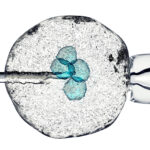In Vitro Fertilization (IVF)
Which Protocol is Best With a Frozen Embryo Transfer Cycle?

In vitro fertilization (IVF) can sometimes result in more than one fertilized egg. After the successful transfer of the embryo(s) during that IVF cycle, patients can preserve suitable embryos that remain with cryopreservation or freeze (known as vitrification). When the patient is ready, a preserved embryo can be transferred via frozen embryo transfer, or FET. Which protocol is best with a frozen embryo transfer cycle?
FET pregnancy rates remain outstanding. While there are many protocols in use, two of the most common protocols are medicated protocols and natural cycle protocols.
Medicated vs. Natural Frozen Embryo Transfer Cycles
Medicated cycles typically require less monitoring than natural cycles. Medicated protocols utilize a combination of estrogen and progesterone. This is because in medicated FET cycles, the patient is not making any progesterone on her own, so progesterone replacement is essential. The medical literature is clear that intramuscular progesterone is superior to vaginal progesterone for medicated FET cycles.
For natural cycles, the patient typically makes her own progesterone, so supplemental progesterone may not be necessary. Additionally, natural cycles do not use estrogen.
Frozen Embryo Transfer Pregnancy Rates
The vast majority of the research on this subject suggests that pregnancy rates are comparable and excellent for natural and medicated cycles. Any individual’s response to a specific protocol is impossible to predict in advance. When deciding which protocol is best with a frozen embryo transfer cycle, know that some patients may respond better to a given protocol. Still, the majority of patients will respond well to both protocols.
At Fertility Centers of New England, our goal is to help each of our patients achieve a successful, healthy pregnancy. If you have further questions about the best treatment path for your needs, please contact us to set up your consultation.


